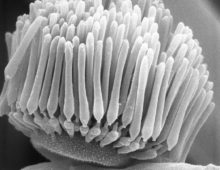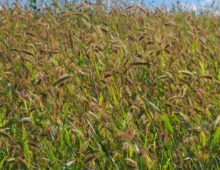Demonstrating the microfluidic-based, mini-metagenomics approach on Yellowstone hot springs samples. The Science Stanford researchers extracted 29 novel microbial genomes from Yellowstone hot spring samples while still preserving single-cell resolution to enable accurate analysis of genome function and abundance. The work was enabled by the Emerging Technologies Opportunity Program (ETOP) of the U.S. Department of Energy…
Tiny Green Algae Reveal Large Genomic Variation
First complete picture of standing genetic variation within a natural population. The Science Ostreococcus are tiny green algae that are the bases of many marine food webs. A decade after the complete representative genomes of three Ostreococcus picoplankton groups were sequenced, researchers have sequenced and analyzed the genomes of 13 members of a natural Ostreococcus…
Mutant Rice Database for Bioenergy Research
Genome-wide rice studies yield first major, large-scale collection of mutations for grass models. The Science Fast-neutron irradiation, exposure to high energy neutrons, induces a wide variety of mutations by making changes in DNA. Using this approach, rice researchers were able to create the first major, large-scale collection of mutations for grass models. Resequencing the 1,504…
Lessons from Simulating A Deep Ocean Oil Spill
Metagenome pipeline helps researchers resolve near-complete microbial genomes involved in Deepwater Horizon oil spill. The Science The 2010 Deepwater Horizon oil spill released 4.1 million barrels of oil into the Gulf of Mexico and was the first major release of oil and natural gases into the deep ocean (1,500 meters). Due to the depth of…
Uncovered: 1000 New Microbial Genomes
Potential biotech applications seen with release of 1,003 reference bacterial and archaeal genomes. The number of microbes in a handful of soil exceeds the number of stars in the Milky Way galaxy, but researchers know less about what’s on Earth because they have only recently had the tools to deeply explore what is just…
Extreme Science: Sequencing in Space
On May 11, 2017, NASA astronaut and microbiologist Kate Rubins, the first woman to sequence DNA in space, gave a talk about “Science in Extreme Environments” at Lawrence Berkeley National Laboratory (Berkeley Lab). Among the anecdotes she shared about living and working in space for nearly 4 months was one on how mundane bench tasks…
Fungal Enzymes Team Up to More Efficiently Break Down Cellulose
Collaborative science initiative enables resolution of fungal protein complexes. One of the biggest barriers in the commercial production of sustainable biofuels is to cost-effectively break down the bioenergy crops into sugars that can then be converted into fuel. To reduce this barrier, bioenergy researchers are looking to nature and the estimated 1.5 million species of…
Finding A New Major Gene Expression Regulator in Fungi
Researchers report prevalent DNA base modification in the earliest fungal lineages Just four letters – A, C, T, and G – make up an organism’s genetic code. Changing a single letter, or base, can lead to changes in protein structures and functions, impacting an organism’s traits. In addition, though, subtler changes can and do happen,…
May 11: Doing Science in Space
With the topic “Doing Science in Space: At 17,500 miles per hour and 250 miles up,” NASA Astronaut Kate Rubins will be speaking at Lawrence Berkeley National Laboratory (Berkeley Lab) on Thursday, May 11, 2017. A livestream of the talk will be available for Berkeley Lab staff here. This visit is co-hosted by the Molecular Foundry and the…
A Gene that Influences Grain Yields in Grasses
Genetic screen identifies mutations that impact green foxtail panicle formation. The Science Through deep sequencing of the model grass green foxtail (Setaria viridis), researchers pinpointed a gene critical for the development of flowers that give rise to the grain. Using this information, a homologous gene in maize was identified as playing a similar role highlighting…








